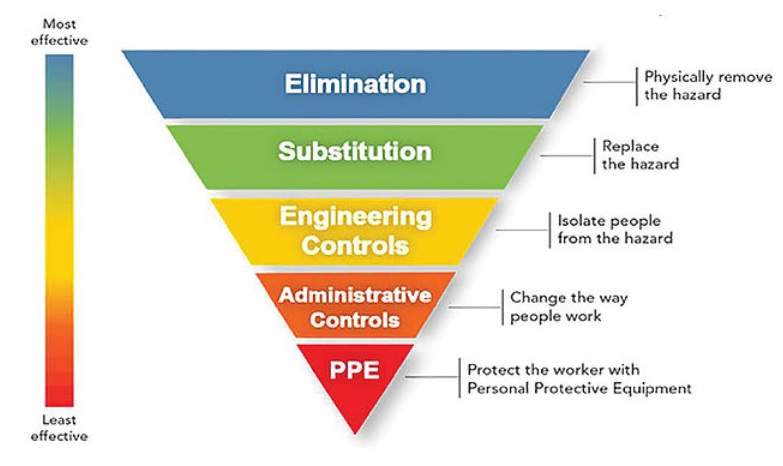
For anyone who works in a mine, or has a loved one in the field, it’s obvious that productivity should never come at the cost of safety. Finding innovative ways to boost productivity while decreasing risk – that’s how true progress is made.
The evolution of safety in mining is long and storied. Some notable examples; the ongoing development of large mining equipment, or electronic blast detonation systems, has a sweeping and dramatic effect on the industry. Safety also increases through strategy and technique. Time and experience reveals new ways to mitigate risk and keep people out of harm’s way.
There are, however, a number of possible approaches to any given hazard faced by operators. How do we know if we’ve found the best solution?
The hierarchy of controls (pictured above) is a useful gauge for solving safety problems in the field. Whenever a hazard is identified, this system offers a simple and clear way to categorise and rank the various solutions. Eliminating the hazard altogether is the most effective and desirable course of action. Personal protective equipment (PPE) is ultimately the least effective. Both of these strategies have their place, but it’s always useful to be critical of our solutions. It pays to seek deeper and more rudimentary answers to the safety-related questions we face.
Let’s look at some real-life examples of safety hazards, and the innovations put forward to solve them, with the hierarchy of controls as our guide.
Vehicle interactions
Since mines generally deal with a lot of traffic, vehicle interactions are a good place to start. Specifically, interactions between heavy and light vehicles is a critical risk. To mitigate risk, smart caps that detect driver fatigue are in circulation. This is a nice innovation; but it straddles the admin and PPE categories at the bottom of the hierarchy. As a standalone solution, it’s not enough.
The installation of proximity detection warning systems in both heavy and light vehicles is another step forward. This is an engineering control; it sits higher up the chart, and significantly improves the safety of roads at mining sites.
But the most effective answer – the one that fits at the top of the chart – has been the separation of light vehicle roads from heavy vehicle haul roads. This is not a piecemeal solution; it eliminates interactions between light and heavy vehicles. Taken together, all three of these measures deliver a meaningful reduction of risk.
Fall of ground
Fall of ground is another challenge that miners must constantly address. Modern technology provides new safeguards – namely radar monitoring, which gives us early warning of highwall movement and allows us to isolate people from potential hazards.
This falls into the ‘engineering control’ category. As a safety measure, radar is entirely worthwhile – but it still doesn’t address the root cause of the hazard. We have to ask what causes fall of ground in the first place. The answer may be that the wall is too steep, and/or has been damaged by blasting and/or water.
What does a top-tier solution to this problem look like? How could we address the root cause and eliminate fall of ground hazards?
There may not be a perfect answer, but electronic blasting will reduce damage. When electronic blasting accuracy is applied by expert engineers, vibration at the highwall can be dramatically reduced. The underlying stability problems that develop into fall of ground can effectively be prevented. This, too, is an engineering control; and when combined with best practice geotechnical design and water management, ‘controlling the hazard’ takes on new meaning.
Electronic blasting also eliminates hazards associated with nonelectric systems – including the snap/slap/shoot phenomenon, as well as unknown misfires. The most advanced blasting hardware on the market today, such as Daveytronic Evolution, provides additional engineering controls by ensuring that the shotfirer is outside of the blast clearance area at the time of firing.
New frontiers in mining safety
It’s an exciting time for the evolution of safety in commercial mining, and we’ve barely scratched the surface. It’s now possible to pair digital sensors with modern software applications, allowing for detailed intelligence on the performance and lifecycles of individual hardware components. This can reduce or eliminate equipment-related mishaps. Autonomous vehicles are another high-level solution that will have a massive impact on safety standards in our industry.
Experience makes it clear that there is no magic bullet to eliminate the various risks inherent to commercial mining. But with the right technology and partnerships, and a meticulous approach to each potential hazard, we can and will reach unprecedented levels of safety and productivity in our industry.

